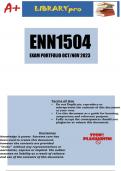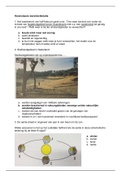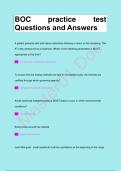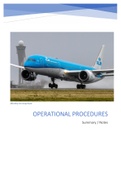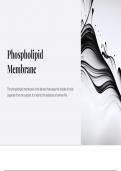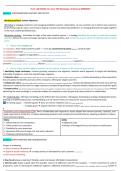Engage: Elimination
Urinary Incontinence Kidney
Filters 120-150 quarts of blood a day
Stress incontinence= Coughing, sneezing, laughing, or physical activity that increases Produces 1 to 2 quarts of urine daily
pressure on the bladder, resulting in urine leakage.
Kidney->ureters->Bladder->urethra->urine
Urge incontinence= A strong need or urge to urinate, but leaking occurs before the client
gets to the toilet.
Reflex incontinence= Urinary leakage as a result of nerve damage.
Bladder
Holds up to 2 cups
Overflow incontinence= Incomplete bladder emptying that results in the bladder
3 muscles work together
overfilling when full, leading to urine leakage. 1. Urethra
Functional incontinence= Physical inability to reach the toilet in time. This may be due to 2. Sphincter
3. Pelvic floor muscles
a physical impairment such as being wheelchair bound or having arthritis of the hands,
which can hinder the fine motor skills needed to unbutton clothing. Urine color
Nocturnal enuresis (nighttime bedwetting)= Common in children but may occur in adults
Healthy= light yellow, clear, no cloudiness
who have consumed too much alcohol, who consume caffeine at night, or who take certain
Increase Fluid= dark yellow or amber
medications
Dehydrated= dark brown color
Small Intestine Blood= red tint
Food & liquid mix w/digestive secretions Blackberries/Beets/Rhubarb=reddish urine
Breakdown of Carbs, fats, proteins, vitamins Aloe/Fava beans= dark brown
Absorbs nutrients that help provide energy, growth,and cellular repair
Asparagus= Urine odor
Large Intestine
Liquid is absorbed from waste by-products stool begins to form Constipation
Produces vitamin K Hardened Stool
Medical Interventions= fever, bleeding, ab
Urinary Retention pain, vomiting, low back pain, weightloss
Occurs with immobile/nervous system injury
Incomplete emptying of the bladder
Caused by prostate for men clients
Can cause UTI, Bladder Damage, Kidney Damage, Urinary incontinence
Interventions= high fiber, well hydrated,
Urinary hesitancy= a difficulty when urinating that causes a weak trickling stream of
exercise, bowel training, stool softener, warm
urine and a need to strain mineral oil enema.
Conditions Alter Bowel Elimination
Diverticulouses= small sacs or pouch’s form in the colon
Diarrhea
Diverticulitis= inflamed pouch or sac in the colon Acute= 1-2 days
Irritable Bowel Syndrome= Ab pain and changes to bowl elimination patters that can Persistent= 2-4 weeks
include diarrhea/constipation Chronic= +4 weeks
Bowel Obstruction= a partial or complete blockage of the small or large bowel Frequent, loose, watery stool
Ileus= the flow of intestinal contents decreases or stops
Dehydration & malabsorption can occur
Symptoms= inability to tolerate food,nausea,vomiting
Treatment= NPO, NG tube, IV Fluid
Ulcerative Colitis= chronic disease causes inflam. & ulcers of the large intestine and colon Physiological Conditions
Dehydration
Fecal Diversions UTI
Kidney Stones
Ileostomy = uses terminal end of the small intestine called ileum Kidney Failure
J-Pouch= Internal pouch formed w/ileum. Internal reservoir connects to the Prostate Enlargement
anus after removal of colon and rectum
Kock Pouch= continent ileostomy system forms internal pouch w/valve so
intestinal contents do not escape the ileostomy
Urine Diversions
Dysuria= Pain or discomfort w/urination often due to infection or injury
Urinalysis= Bladder infection,UTI, kidney infection disease, & Diabetes Urethras Stent= a low passage of urine when ureter is
blocked
Urostomy= Section of S.I removed from G.Im, then
Catheter Care Enema attached to Ab wall where Stoma is created into a
pouch
Uretha Insertion= Sterile Tech Instillation of liquid solution through the anus to relieve Nephrostomy= tube drains urine directly from kidney
Condom/external= Clean Tech constipation or cleanse bowel into an external pouch (removal of kidney stone)
Indwelling Catheters = Cleaned Neobladder= reservoir surgically created from piece
Cleansing Enema= retain fluid for 15-30 min of bowel
Daily w/soap & water
Solutions: Continent Cutaneous Reservoir= placed in aB instead
• tap water (Hypotonic) mineral oil of pelvis
• 0.9% saline (isotonic) Cystostomy= catheter inserted directly into the
• Sodium phosphate bladder & attached to a drainage bag outside clients
abdomen
Urinary Incontinence Kidney
Filters 120-150 quarts of blood a day
Stress incontinence= Coughing, sneezing, laughing, or physical activity that increases Produces 1 to 2 quarts of urine daily
pressure on the bladder, resulting in urine leakage.
Kidney->ureters->Bladder->urethra->urine
Urge incontinence= A strong need or urge to urinate, but leaking occurs before the client
gets to the toilet.
Reflex incontinence= Urinary leakage as a result of nerve damage.
Bladder
Holds up to 2 cups
Overflow incontinence= Incomplete bladder emptying that results in the bladder
3 muscles work together
overfilling when full, leading to urine leakage. 1. Urethra
Functional incontinence= Physical inability to reach the toilet in time. This may be due to 2. Sphincter
3. Pelvic floor muscles
a physical impairment such as being wheelchair bound or having arthritis of the hands,
which can hinder the fine motor skills needed to unbutton clothing. Urine color
Nocturnal enuresis (nighttime bedwetting)= Common in children but may occur in adults
Healthy= light yellow, clear, no cloudiness
who have consumed too much alcohol, who consume caffeine at night, or who take certain
Increase Fluid= dark yellow or amber
medications
Dehydrated= dark brown color
Small Intestine Blood= red tint
Food & liquid mix w/digestive secretions Blackberries/Beets/Rhubarb=reddish urine
Breakdown of Carbs, fats, proteins, vitamins Aloe/Fava beans= dark brown
Absorbs nutrients that help provide energy, growth,and cellular repair
Asparagus= Urine odor
Large Intestine
Liquid is absorbed from waste by-products stool begins to form Constipation
Produces vitamin K Hardened Stool
Medical Interventions= fever, bleeding, ab
Urinary Retention pain, vomiting, low back pain, weightloss
Occurs with immobile/nervous system injury
Incomplete emptying of the bladder
Caused by prostate for men clients
Can cause UTI, Bladder Damage, Kidney Damage, Urinary incontinence
Interventions= high fiber, well hydrated,
Urinary hesitancy= a difficulty when urinating that causes a weak trickling stream of
exercise, bowel training, stool softener, warm
urine and a need to strain mineral oil enema.
Conditions Alter Bowel Elimination
Diverticulouses= small sacs or pouch’s form in the colon
Diarrhea
Diverticulitis= inflamed pouch or sac in the colon Acute= 1-2 days
Irritable Bowel Syndrome= Ab pain and changes to bowl elimination patters that can Persistent= 2-4 weeks
include diarrhea/constipation Chronic= +4 weeks
Bowel Obstruction= a partial or complete blockage of the small or large bowel Frequent, loose, watery stool
Ileus= the flow of intestinal contents decreases or stops
Dehydration & malabsorption can occur
Symptoms= inability to tolerate food,nausea,vomiting
Treatment= NPO, NG tube, IV Fluid
Ulcerative Colitis= chronic disease causes inflam. & ulcers of the large intestine and colon Physiological Conditions
Dehydration
Fecal Diversions UTI
Kidney Stones
Ileostomy = uses terminal end of the small intestine called ileum Kidney Failure
J-Pouch= Internal pouch formed w/ileum. Internal reservoir connects to the Prostate Enlargement
anus after removal of colon and rectum
Kock Pouch= continent ileostomy system forms internal pouch w/valve so
intestinal contents do not escape the ileostomy
Urine Diversions
Dysuria= Pain or discomfort w/urination often due to infection or injury
Urinalysis= Bladder infection,UTI, kidney infection disease, & Diabetes Urethras Stent= a low passage of urine when ureter is
blocked
Urostomy= Section of S.I removed from G.Im, then
Catheter Care Enema attached to Ab wall where Stoma is created into a
pouch
Uretha Insertion= Sterile Tech Instillation of liquid solution through the anus to relieve Nephrostomy= tube drains urine directly from kidney
Condom/external= Clean Tech constipation or cleanse bowel into an external pouch (removal of kidney stone)
Indwelling Catheters = Cleaned Neobladder= reservoir surgically created from piece
Cleansing Enema= retain fluid for 15-30 min of bowel
Daily w/soap & water
Solutions: Continent Cutaneous Reservoir= placed in aB instead
• tap water (Hypotonic) mineral oil of pelvis
• 0.9% saline (isotonic) Cystostomy= catheter inserted directly into the
• Sodium phosphate bladder & attached to a drainage bag outside clients
abdomen

